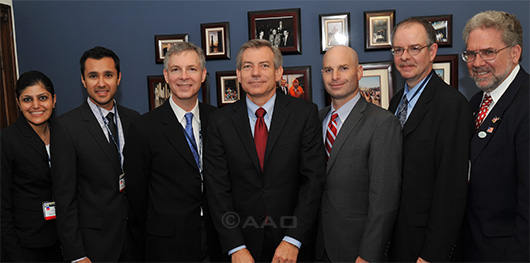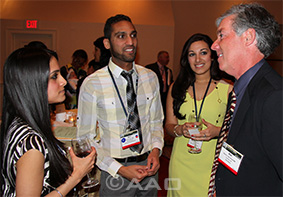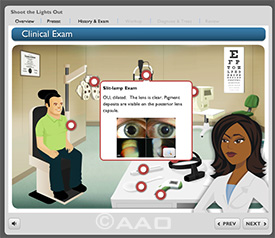What's Happening
2013 Mid-Year Forum
In early April, more than 400 ophthalmologists gathered in Washington, D.C., to discuss some of ophthalmology’s most critical issues with regulators, legislators, and Academy leaders. EyeNet touches on three Mid-Year Forum (MYF) sessions below.
- Eyes Wide Open: What Ophthalmologists Need to Know to Navigate Integrated Health Care. Accountable care organizations (ACOs) are but one result of the megatrend toward increasing levels of clinical integration. The strategies and solutions for confronting integration vary tremendously based on practice size, location, and the behavior of your local marketplace. This session provided an overview of clinically integrated networks and ACOs, real-world examples, and advice for those who wish to plan now for a successful future in ophthalmology. The watchword: Stay alert.
- The Workforce Puzzle: Uses and Abuses of Mid-Level Practice Extenders. The demographics of health care mandate a team approach to eye care in the future. For ophthalmology, there are a number of potential models today that could involve employed optometrists, physician assistants, or nurse practitioners. This session explored these options from medical, ethical, legal, and business perspectives. A panel responded to potential ophthalmic practice scenarios, eliciting robust audience participation.
- Patient-Centered Care: I Can’t Get No Satisfaction. Metrics for patient satisfaction are increasingly being publicly reported and tied to financial incentive payments for hospitals and physicians. This session described the environmental factors contributing to patient-centered care and patient satisfaction initiatives, illustrated successful cases of ambulatory practices meeting patient needs, and clarified the ophthalmologist’s role in measuring, interpreting, and applying patient-reported results in everyday practice.
To view the MYF Report, visit www.aao.org/myf.
 |
CONGRESSIONAL ADVOCACY DAY. Academy members from Arizona met with Rep. David Schweikert (R-Ariz.) to discuss issues affecting ophthalmology. From left to right: Ami A. Shah, MD, Malav Joshi, MD, Brian T. Rose, MD, Rep. Schweikert, Jeff S. Maltzman, MD, Thomas J. McPhee, MD, and Robert C. Spurny, MD.
|
Advocacy Ambassadors at the Mid-Year Forum
 |
| MYF. Residents Nisha Warrier, MD, Neil Vyas, MD, and Ann Jayaram, MD, get advocacy tips from Dr. Briceland. |
In April, a record 160 members in training were sponsored by state, subspecialty, and specialized-interest societies and training programs to attend the 2013 Mid-Year Forum and Advocacy Day via the Academy’s Advocacy Ambassador Program.
During a briefing for the ambassadors, Academy Secretary for State Affairs Daniel J. Briceland, MD, explained the key priorities for ophthalmology at the federal level as well issues impacting patients and quality eye care at the state level. He emphasized how important it is for young ophthalmologists to be active at the state level.
During the briefing, Academy President Paul Sternberg Jr., MD, stressed that “residents played a key and vital role during the recent legislative battle in Tennessee.” He urged all Academy ambassadors to be active within their respective states.
Take Notice
SOE: Visit the Academy Booth
Visit the Academy at Booth 66 during the European Society of Ophthalmology (SOE) 2013 Congress. You can view the latest Academy products, get information about the Academy’s 2013 Annual Meeting, and have your membership questions answered. You can also pick up an EyeNet issue to leaf through between sessions. The SOE 2013 Congress will be held June 8 to 11 in Copenhagen, Denmark.
Save the Date: IOL Workshop
On Oct. 11, the Academy and the Food and Drug Administration (FDA) will jointly sponsor a Premium IOL Workshop for clinicians, academicians, federal employees, and industry experts to identify challenges to intraocular lens (IOL) innovation and develop an action plan for delivering premium IOL technologies more quickly to market. The workshop will take place on the FDA White Oak campus in Silver Spring, Md. Space is limited, so register early.

ONE SPOTLIGHT: Test Your Clinical Knowledge With Real-Life Cases. For interactive, case-based reviews of eye disorders, visit Academy Grand Rounds on the ONE Network. Each case is based on an actual encounter and allows you to walk through the steps virtually: Review the patient’s history and symptoms, examine the patient in the interactive exam room, choose diagnostic tests, and see if your diagnosis and treatment strategy are appropriate. All cases are eligible for AMA PRA Category 1 Credit, and new cases are added regularly. Recent cases in
clude the following:
- Little Eye, Big Problem: A twin baby girl is referred by her neonatologist for suspected retinopathy of prematurity.
- Shoot the Lights Out: A 42-year-old man complains of a severe headache that began as ocular pain while playing basketball.
To explore a case, visit www.aao.org/one. Under “Educational Content,” click “Academy Grand Rounds.” |
Academy Store
Test Your Knowledge
ProVision: Ophthalmic Multiple-Choice Questions With Discussions, Series 5, is a comprehensive self-assessment program to prepare residents for exams or help practicing ophthalmologists identify gaps in clinical knowledge. The text features 550 multiple-choice questions that cover all 11 practice emphasis areas. It also includes thorough discussions of the correct answers, with numerous photos, diagnostic images, and suggested resources and references for further study.
ProVision, Series 5, was written and reviewed by a panel of leading ophthalmologists. The question-and-answer format is ideal for those who want an interactive activity that will quickly identify strengths or areas for improvement.
For more information and to purchase, visit www.aao.org/provision.
Time Is Running Out: Get the 2013 Coding Books
The Academy and American Academy of Ophthalmic Executives’ ophthalmology-specific coding books for 2013 can help you code accurately; however, they are only available for purchase until July 31. Order them today to make sure you are using the most upto-date edition available. Receive a 10 percent discount when you buy four or more coding products.
To see all the titles, visit www.aao.org/codingproducts.
D.C. Report
Options for Pediatric Vision Benefit
The health care reform law requires that health plans available through state health insurance exchanges offer a minimum package of items and services—these are known as essential health benefits (EHBs). Ten categories of EHBs must be covered, one of which is “pediatric services, including oral and vision services.”
Lobbying for a sustainable vision benefit. The Academy, along with the American Academy of Pediatrics and the American Association for Pediatric Ophthalmology and Strabismus, urged the U.S. Department of Health and Human Services (HHS) to adopt an evidence-based pediatric vision benefit that covers timely screenings for children; referrals for comprehensive eye examinations; and further vision, medical, and surgical treatment when necessary. The Academy believes that this is a cost-effective approach for children’s eye care and that the benefit will remain affordable and available.
HHS delegates decision making to the states. Instead of spelling out the specifics of the EHBs, HHS decided to let each state use an existing local plan as a base plan, or a benchmark, for defining the EHBs in 2014 and 2015. However, most base plans do not include pediatric vision coverage. Therefore, the agency proposed the federal employee vision plan as the benchmark for these pediatric services. This plan includes an annual comprehensive eye exam, glasses or contacts, and discounts on LASIK/PRK surgery. The Academy argued that this federal employee plan—designed to meet the increased eye care needs of working adults—is not a good model for pediatric coverage, as only 5 to 7 percent of children have an eye problem that requires vision care. As a result, HHS also allowed the states to use their Children’s Health Insurance Program (CHIP) as an additional benchmark. Seven states have opted to use CHIP as the benchmark; more than 40 states and U.S. territories opted to use the federal vision plan.
Cost concerns. Small businesses, employers, and insurers are increasingly worried about the impact the EHB requirements will have on the affordability of health plans in the exchanges, and states may revisit their choices for 2016. HHS is required to periodically review and update the EHB package. The Academy will continue to work for an evidence-based and cost-effective children’s eye care benefit.
Members at Large
People
On June 9, Alfred Sommer, MD, MHS, is scheduled to receive the Dan David Prize at a ceremony at Tel Aviv University for his research in the 1970s that showed high-dose oral vitamin A could, at the cost of 4 to 6 cents per child, prevent up to 400,000 cases of blindness and 1 million deaths each year.
“Al Sommer’s career has been characterized by careful science, analytic insights, and integrity. His work has had a direct and immediate impact felt around the globe. The Academy awarded him its Laureate medal, and we are all extremely proud that he represents our profession,” said Academy Executive Vice President and CEO David W. Parke II, MD. Dr. Sommer is currently professor of epidemiology and international health at the Johns Hopkins Bloomberg School of Public Health.
The Dan David Prize recognizes groundbreaking and interdisciplinary research, and promotes scientific, technological, and humanistic achievements.
Passages
The 2012 Academy Laureate, Stephen J. Ryan, MD, passed away on April 29. He was 73.
A clinician-scientist, retinal physician, and pioneering researcher, Dr. Ryan was honored as the Academy Laureate at the 2012 Joint Meeting for his distinguished career and contributions to ophthalmology. Not only did he transform the Doheny Eye Institute into a top ophthalmic training and research center over the last four decades, but he also instigated the first animal model of choroidal neovascularization for examining the pathogenesis and treatment of neovascular diseases such as AMD.
“Ophthalmology the world over has lost one its greatest achievers and most prestigious talents. Steve Ryan helped build one of the most significant institutes in ophthalmology and was one of our greatest scientists, clinicians, and strategic leaders. The ripples from his work will last generations,” said David W. Parke, II, MD, Academy Executive Vice President and CEO.
Dr. Ryan received his medical degree from the Johns Hopkins School of Medicine in 1965, and completed his residency at the Wilmer Eye Institute in 1969. He was the founder and president of the National Alliance for Eye and Vision Research, the president of the Doheny Eye Institute, and chairman of the board of the Arnold and Mabel Beckman Foundation, among other positions.
For more on Dr. Ryan, read “A Lifetime Laying the Foundations for Tomorrow’s Discoveries.” This article was first published in Academy News, the convention hall newspaper that was distributed at the 2012 Joint Meeting in Chicago. For an interview with Dr. Ryan, visit the Museum of Vision’s oral history section.